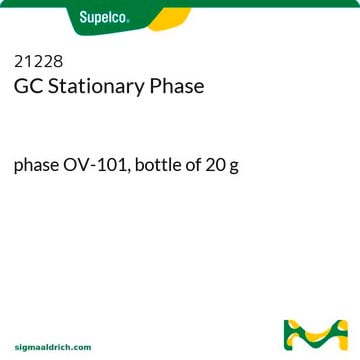Recommended Products
agency
meets requirements for USP G19
packaging
bottle of 5 g
parameter
0-265 °C temp. range
technique(s)
gas chromatography (GC): suitable
matrix active group
OV-225 phase
solubility
acetone: soluble
column type
packed GC
General description
GC methods are divided into two classes depending on the nature of stationary phases; gas-solid chromatography (GSC) and gas-liquid chromatography (GLC). GSC has solid adsorptive material and solute particles are removed from mobile phase by electrostatic forces. GLC has a thin layer of liquid coated or bonded on the surface of an inert particle or on the walls of the column where solute particles are retained in the liquid phase based on their partition coefficients. The primary necessity of a stationary phase is to provide sample separation sustaining phase integrity over a reasonable period of time. It should be stable for the chemical and thermal changes. Selectivity, peak symmetry, analysis time, degree of separation, peak tailing are a few parameters that should be considered in order to choose a stationary phase. OV-225 is a polar siliconised phase. It has 50% methysilicone, 25% cyanopropyl and 25% phenyl-silicone. It is possible to separate aromatic compounds from aliphatic ones containing the same number of carbons.
Synthesized specifically to be purer, of narrow molecular weight range, and without trace catalysts or impurities for use as a GC stationary phase.
Application
OV-225 on columns is suitable for resolving neutral and amino sugars during chemical analysis using gas chromatograph.
Storage Class
12 - Non Combustible Liquids
wgk_germany
WGK 3
flash_point_f
Not applicable
flash_point_c
Not applicable
ppe
Eyeshields, Gloves
Choose from one of the most recent versions:
Certificates of Analysis (COA)
Lot/Batch Number
Sorry, we don't have COAs for this product available online at this time.
If you need assistance, please contact Customer Support.
Already Own This Product?
Find documentation for the products that you have recently purchased in the Document Library.
S J Millar et al.
Infection and immunity, 51(1), 302-306 (1986-01-01)
Two separate species of lipopolysaccharide (LPS) from Bacteroides gingivalis 381 have been isolated. Sodium dodecyl sulfate-polyacrylamide gel electrophoresis demonstrated not only the heterogeneity of each species, but also that they represented high- and low-molecular-weight LPS entities. Although both contained the
Michael O'Keefe
Residue Analysis in Food: Principles and Applications, 187-187 (2000)
David B. Troy, Paul Beringer
Remington: The Science and Practice of Pharmacy, 605-605 (2006)
James P. Lodge, Jr.
Methods of Air Sampling and Analysis, 98-98 (1988)
Our team of scientists has experience in all areas of research including Life Science, Material Science, Chemical Synthesis, Chromatography, Analytical and many others.
Contact Technical Service






